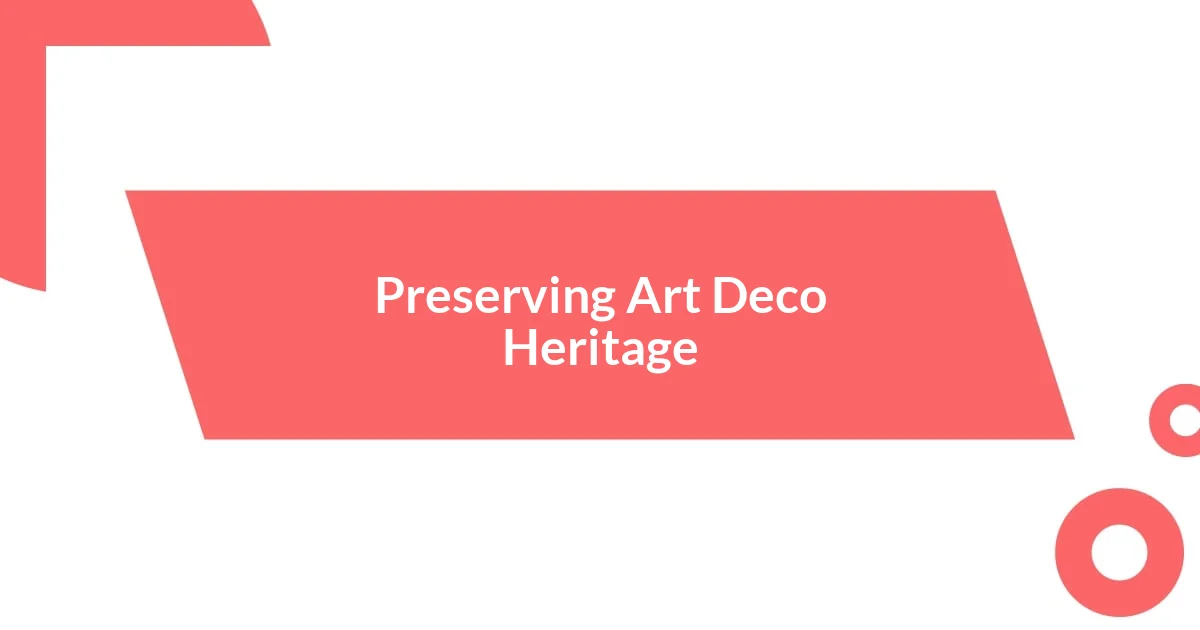Key takeaways:
- Art Deco flourished in the 1920s and 1930s, reflecting post-World War I optimism and modernity through its geometric designs and vibrant materials.
- Iconic structures, like the Chrysler Building and the Art Deco District in Miami, exemplify the movement’s fusion of artistic expression and architectural innovation.
- Efforts to preserve Art Deco heritage highlight its cultural significance, invoking community engagement and appreciation of historical craftsmanship.

Introduction to Art Deco Features
Art Deco, a design movement that peaked in the 1920s and 1930s, captivated me from the very first time I laid eyes on its bold lines and luxurious materials. The style’s embrace of geometric shapes and vibrant colors creates an almost palpable energy—it’s as if each piece whispers stories of the era’s exuberance and elegance. Have you ever walked into a space that felt alive with history? That’s the magic of Art Deco.
What truly draws me in are those intricate details found in everything from architecture to furniture. I recall wandering through a historic hotel with stunning Art Deco elements—each curve and pattern felt like a conversation with the past. The combination of form and function in Art Deco features reminds me how design can elevate everyday items into pieces of art. Isn’t it fascinating how a simple lamp can be transformed into a striking statement piece?
In exploring Art Deco features, I find myself appreciating the juxtaposition of industrial materials alongside decorative motifs. The use of chrome, glass, and rich woods creates a sense of modernity while still honoring craftsmanship. Do you see how the style manages to balance between the opulent and the minimalist? It’s this unique blend that makes Art Deco so compelling and timeless in its appeal.

Historical Context of Art Deco
Art Deco emerged in the aftermath of World War I, reflecting a world yearning for renewal and optimism. The 1925 International Exposition of Modern Industrial and Decorative Arts in Paris sparked widespread interest in this style, showcasing a synthesis of fine art and manufacturing that felt refreshing. I remember visiting the exposition hall’s remnants, and it struck me how that event truly symbolized a cultural revolution, celebrating modernity in every corner.
As an expression of the modern age, Art Deco drew inspiration from various sources, including ancient civilizations, nature, and emerging technologies. The movement resonated with the changing social landscape, where the flapper culture and jazz music embodied a sense of liberation and progress. Walking through a city dotted with Art Deco buildings, I couldn’t help but feel that same vibrancy as I imagined the lively gatherings that took place in the roaring twenties.
The historical context of Art Deco also intertwines with the rise of the middle class and consumer culture, which pushed for decorative arts that appealed to the masses. This was a time when materials like aluminum and stainless steel became symbols of modern luxury. I often find myself reflecting on how these shifts in society influenced our everyday surroundings and the way we engage with design. It feels as if each Art Deco piece tells a story, an embodiment of aspirations shaped by history.
| Era | Characteristics |
|---|---|
| Post World War I | Renewal and optimism; use of geometric shapes and vibrant colors |
| 1925 Exposition | Showcase of modern design and artistry; cultural revolution |
| Consumer Culture | Impact of middle class; incorporation of modern materials |

Key Characteristics of Art Deco
Art Deco is characterized by a striking blend of elegance and modernity that captures the exuberance of its era. I vividly remember the first time I gazed at an Art Deco building—the bold lines and intricate detailing made my heart race. It’s a style that embraces symmetry and intricate ornamentation, merging form with a sense of glamour that feels almost intoxicating in its beauty.
Here are some key characteristics that define Art Deco:
- Geometric Shapes: Sharp angles and repetitive motifs create a sense of structure and precision.
- Rich Materials: Luxurious elements like chrome, glass, and polished wood reflect light and add depth.
- Vibrant Colors: A bold palette often featuring deep hues, gold, and silver bring a sense of vitality.
- Ornamentation: Decorative details, such as zigzags and floral patterns, give pieces a unique flair.
- Streamlined Forms: Smooth, curved lines that suggest speed and elegance.
In spaces adorned with Art Deco features, I often feel transported back in time to the glitz and excitement of the Roaring Twenties. My experience wandering through a vintage Art Deco theater—where every detail from the massive chandeliers to the stylized geometric patterns seemed to pulsate with energy—deepens my appreciation for this exquisite aesthetic. This architectural style effortlessly encapsulates a moment in history, vibrant and full of life, that still resonates with us today.

Iconic Art Deco Structures
One of the most iconic Art Deco structures that comes to mind is the Chrysler Building in New York City. I still remember the rush of emotions I felt the first time I stood before it. Its elegant spire, reaching toward the sky, seemed to embody the ambition of the era. The intricate gargoyle faces and the gleaming chrome accents make it not just a building, but a true work of art. Can you imagine the excitement of its unveiling in 1930? It was a race to the heavens, reflecting a newfound confidence post-World War I.
The Palais de Tokyo in Paris is another stunning example that captivated me during my travels. As I wandered its expansive halls, I marveled at how the building itself was a perfect fusion of artistic expression and architectural innovation. The bold geometric patterns and striking use of color invite you to engage and explore. Have you ever felt art wrap around you like a warm embrace? That’s precisely what I experienced there, a feeling that history and modernity can coexist beautifully within a single structure.
A personal favorite of mine, the Art Deco District in Miami, is an absolute treasure trove of architectural splendor. Strolling along Ocean Drive, I found myself enveloped in a kaleidoscope of pastel hues and streamlined designs. Each building seems to whisper stories of mid-century glamour and sun-kissed celebrations. It’s fascinating to think about the dynamic cultural environment that helped shape these structures. Doesn’t it make you wonder how many lives have been touched by the magic of Art Deco? Every corner turned reveals a new facet of history layered with nostalgia.

Personal Encounters with Art Deco
The first time I walked down Deco Drive in Miami, I felt as if I had stepped into a vibrant time capsule. The pastel-colored buildings, bathed in the glow of the setting sun, made my heart flutter with nostalgia for an era I never lived in. Each structure seemed to tell a story, making me wonder—how many joyful moments unfolded beneath these intricate facades?
On a trip to a local museum, I encountered a breathtaking Art Deco lamp that showcased the craftsmanship of the period. It wasn’t just a light; it embodied sophistication and artistry, making me ponder how everyday objects can become statements of style and elegance. I caught myself imagining how it would have transformed a cozy room in the 1920s, surrounding its occupants with warmth and charm, sparking conversations full of dreams and aspirations.
At a recent architectural tour, my excitement peaked when I stood in front of a restored Art Deco hotel. The way the sun danced off the polished surfaces and how the geometric patterns framed the entrance felt like witnessing a live performance. Have you ever had a moment where architecture almost seems alive? This experience reminded me of the power of Art Deco to evoke emotion—it’s not just about visual appeal but also a connection to history that resonates within us.

Preserving Art Deco Heritage
Preserving Art Deco heritage is a vital aspect of maintaining our cultural identity. I recall visiting a local city council meeting where passionate residents rallied to protect a beloved Art Deco theater facing demolition. Seeing the community come together to advocate for the preservation of such a significant piece of history filled me with hope. Isn’t it amazing how architecture can unite us in a shared purpose?
As I explored various neighborhoods, I learned that many Art Deco buildings are not only beautiful but also tell stories of resilience and innovation. I remember my encounter with a small restoration project that aimed to revive an old Art Deco cinema. The owners shared their vision of bringing back its original luster, and I felt their enthusiasm as they uncovered forgotten details. It made me realize just how crucial these efforts are—each restored feature becomes a timeless reminder of a glamorous past.
It’s interesting to consider how modern updates can blend seamlessly with Art Deco styles. I’ve seen developers skillfully incorporate contemporary amenities while respecting the design’s original spirit in several renovated buildings. Have you ever walked into a space where old and new harmoniously coexist? Witnessing that fusion fills me with appreciation for the architects who navigate this delicate balance, ensuring that the legacy of Art Deco continues to inspire future generations.















